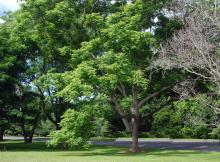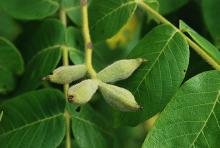Juglans ailantifolia
Common name:
Japanese Walnut
Heartnut
Pronunciation:
JU-glanz a-lan-ti-FO-lee-a
Family:
Juglandaceae
Genus:
Synonyms:
Juglans sieboldiana
Type:
Broadleaf
Native to (or naturalized in) Oregon:
No
- Broadleaf, deciduous tree, to 40-65 ft (15-20 m) tall, broad, round crown. Leaves alternate, pinnately compound, 60 cm long, odd number of leaflets, 11 to 17, each leaflet ovate-oblong to oblong, 7-18 cm long, serrate, upper surface bright green, pubescent at first but then glabrous or nearly, pubescent below, and densely granular and pubescent on the midrib and leaf stalk (rachis). Male catkins 15-30 cm long; female catkins with 12-20 flowers. Fruit globose to ovoid, sticky, rugose, thick shelled, 2.5-3.5 cm long; recovery of the intact kernel upon cracking is poor (see below).
- Sun
- Hardy to USDA Zone 5 Native to Japan; introduced in 1860
- A sport of the Japanese walnut, Juglans ailantifolia var. cordiformis, is known as the Heartnut because of its heart-shaped nuts (cordiformis = heart-shaped). Cultivars of Heartnut have been developed and are grown commercially. The nuts of these selections easily crack at the suture and released the heart-shaped kernel in one or two pieces.
- ailantifolia: ailanti, from Ailanthus, the Tree of Heaven, and folia, leaf. Its large green leaves, with 11-17 leaflet, are reminiscent of those of the Tree of Heaven, Ailanthus altissima.







